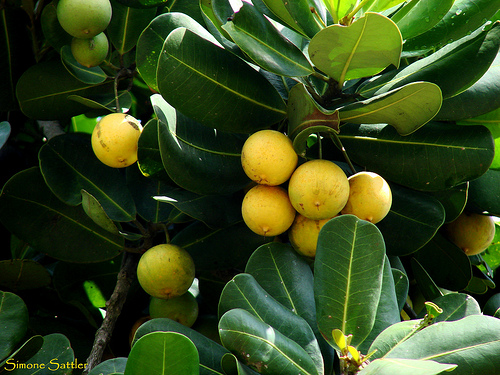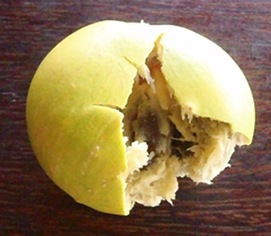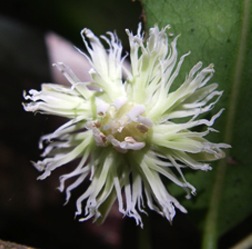Monkey’s Apple is proof kids will eat anything.
Many people who grew up with them recall eating a lot of the fruit as a child but can barely stand one as an adult. What was a fun outdoor snack at 10 turns into a mealy, acrid famine food at 30 which is not unusual because the plant comes from the Sapotaceae family one known for producing barely edible fruit. But, it is edible.
Originally from Madagascar, Monkey’s Apple is well-established in the tropics from Southern Florida to Northern Australia. The leaves are leathery thus the name of the plant, coriacea. Fruit are yellow when ripe with three or so (2-4) non-edible seeds, dark brown, very hard, full of tannin. The yellow flesh is sticky, one of reasons why children are attracted to it. When very ripe the tree rains golf-ball sized fruit that approach being sweet. Birds usually won’t eat them but rodents squirrel them way and giant tortoises like to eat the fruit. However, at the famous Fairchild Tropical Botanic Garden in Miami they just call them “inedible.” They are not on the top of the foraged food list.
Botanically the tree is Mimusops coriacea, MIM-you-sops kor-ee-uh-KEE-us. The genus Mimusops comes from the Greek words, mimo meaning ape, and ops meaning resembling. In English we would say “looks like a monkey.” No one knows why that is the botanical name. As mentioned coriacea is Dead Latin for leather. The Creole call it Pomme Zako, from the French Pomme Jacquot. That might have been Pomme d’accot originally that got mutated into Pomme Jacquot (then Pomme Zako.) And while that means Apple of Sheltering in English we might call it Mulch Apple, a tree producing mulch. Perhaps that is a fitting name for a tree that has made it way onto the Global Compendium of Weeds. Its spread in south Florida is of great concern. West Palm Beach, where I teach classes, specimens have been found.
As for eating the ripe, tough skinned fruit they are squeezed between the fingers. Don’t eat the seeds and avoid white globs from the skin. The flesh is sticky and leaves a coating in the mouth. Seed have been made into necklaces and the seed oil sued used in paint. A close relative that can be found in south Florida is the Spanish Cherry.
Green Deane’s Itemized Plant Profile: Monkey’s Apple
IDENTIFICATION: Mimusops coriacea: Evergreen tree to 70 feet, twisting trunk, dense crown, used as a timber wood. Leaves simple, alternating, usually grouped towards the end of the branches, elliptical or obovate or oblong to eight inches long, five inches wide, leathery, hairless, bright green, strong midrib. Flowers in bundles, eight stamens. You can tell it from another related species, Spanish Cherries, Mimusops elengi, by notched leaf tips and larger fruit. Also Mimusops balata may be M. coriacea. Botanists can’t agree.
TIME OF YEAR: In the northern hemisphere, fruits late fall
ENVIRONMENT: Coastal tropical regions, distrubed ground. Rarely cultivated.
METHOD OF PEPARATION: Fruit pulp raw.






Looks like you could use them as a carrier for other flavours? Perhaps to give bulk to chutneys and jams? There is ALWAYS a way to incorporate easily grown fruits like these and where there is a will there is a way 🙂